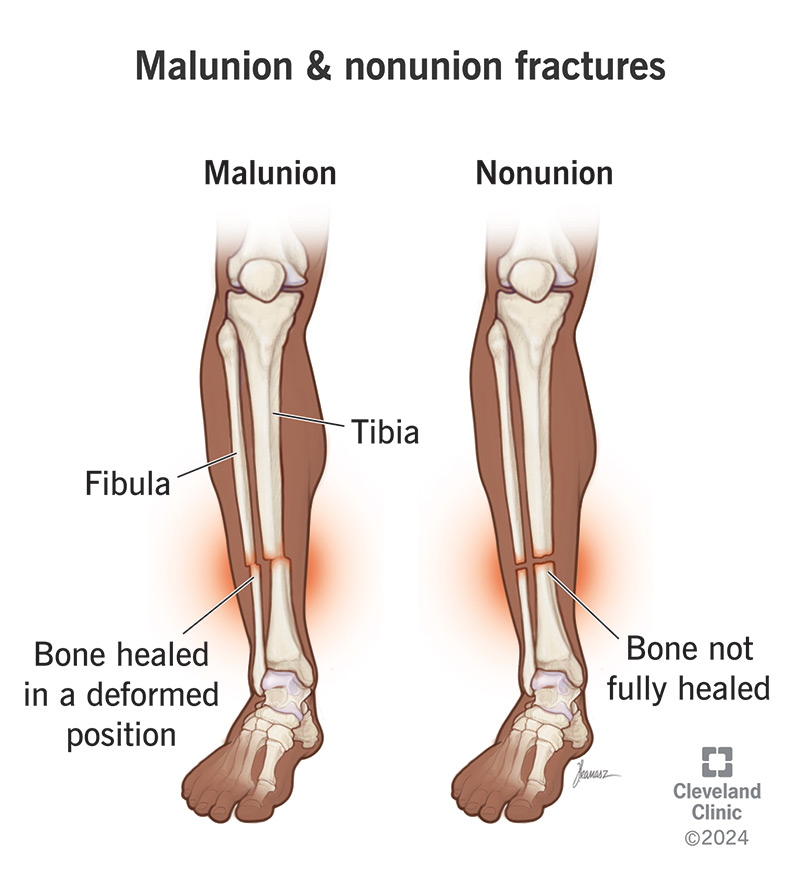When bone fractures don’t heal well, it’s called malunion or nonunion. A malunion is a fracture that healed in the wrong position. A nonunion is a fracture that’s failed to heal. Various mechanical and biological factors can interfere with bone healing. Your healthcare team will address these when treating your malunion or nonunion.
Advertisement
Cleveland Clinic is a non-profit academic medical center. Advertising on our site helps support our mission. We do not endorse non-Cleveland Clinic products or services. Policy

Malunion and nonunion fractures are poorly healed bone fractures. A malunion fracture is one where the fractured bone parts have grown back together, but in the wrong position. A nonunion fracture is one where the fractured parts have failed to grow back together, even though they’ve had more than enough time to do so. Poorly healed fractures can impact your skeleton’s stability and functionality.
Advertisement
Cleveland Clinic is a non-profit academic medical center. Advertising on our site helps support our mission. We do not endorse non-Cleveland Clinic products or services. Policy
Most bone fractures heal well with good care. If they don’t, it’s because something has inhibited the healing process. Sometimes, it’s a mechanical issue: The fractured parts didn’t hold together well during healing. It can also be a biological issue: Somehow, your body’s resources for healing weren’t up to the task. Healthcare providers must address these factors when treating malunion and nonunion fractures.
Your healthcare provider may classify your nonunion fracture as hypertrophic, atrophic or oligotrophic. These classifications are based on the evidence of what types of factors are preventing it from healing.
Advertisement
A malunion fracture might look like:
Using a bone with a malunion fracture may cause:
As your bones are all connected, weakness at the malunion can put extra stress on other parts of your skeleton. This may cause pain in another area of your body when you use the injured bone.
If your misplaced bones stretch or entrap a nerve, you may have nerve-related symptoms, like:
Signs and symptoms of a nonhealing fracture may include:
If you have an infection in the bone, you may or may not have symptoms, such as:
Many factors can contribute to bone fracture malunion and nonunion, including:
Diagnosis begins with a complete medical history of your injury and other conditions. Then, your provider will physically examine your bone. They’ll look for visible deformities and gently move it, asking how it feels. Depending on where it is, they might want to watch you walk or measure its length. They’ll follow up with imaging of the bone. Imaging may include X-rays, a CT scan or an MRI.
Your provider will diagnose malunion if they find that the bone has healed in a non-anatomical position. They’ll diagnose delayed union or nonunion if your bone has failed to start or finish healing after a reasonable recovery period. Healing times can vary based on your injury, the bone involved and your overall health status. Your provider may diagnose fracture nonunion after six, nine or 12 months.
Not all malunion and nonunion fractures need to be fixed. It depends on the bone involved, how much you use it and how much the fracture impacts your day-to-day life. But some nonhealing fractures can limit your mobility and cause pain or other complications. When this is the case, you might need surgery to fix it. Your provider will suggest nonsurgical treatment options first, and surgical options if needed.
Advertisement
Nonsurgical treatments for malunion fractures may include:
Surgery for a malunion fracture may include:
Nonsurgical treatments for nonunion fractures may include:
Surgery for a nonunion fracture may include:
Advertisement
Both nonsurgical and surgical treatments have high success rates for fixing malunion and nonunion fractures. But healing and rehabilitation can take some time. You may need to use a cane or walker to walk while healing, and you’ll spend some time in physical therapy afterward. The treatment may fail if the bone doesn’t stay in position or if your provider can’t control the biological factors involved.
A bone fracture can happen to anyone, and it’s not always obvious when you’ve fractured a bone. But if you think it’s possible, it’s best to see a healthcare provider to check. Fractures heal better when they get early, quality care. Your provider will assess your injury and identify the factors that could interfere with healing. They’ll advise you on how to best take care of yourself to prevent a malunion or nonunion.
Advertisement
From sudden injuries to chronic conditions, Cleveland Clinic’s orthopaedic providers can guide you through testing, treatment and beyond.

Last reviewed on 01/23/2025.
Learn more about the Health Library and our editorial process.